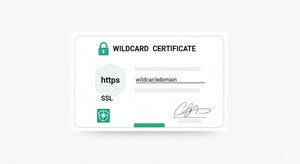Body
SSL certificates play a vital role in securing data exchanged between a website and its visitors. They encrypt communication and display the secure padlock icon in browsers, reassuring users their information is safe.
A wildcard SSL certificate goes one step further. Instead of protecting just one domain, it secures a primary domain and all its subdomains. That's a game-changer for businesses with multiple services or departments online.
Whether you run an e-commerce site or a growing SaaS platform, an SSL wildcard certificate simplifies your security strategy and saves you time and money.
What Is a Wildcard SSL Certificate?
A wildcard SSL certificate allows you to secure an unlimited number of subdomains under a single domain. For example, if your primary domain is example.com, the wildcard SSL will protect mail.example.com, store.example.com, blog.example.com, and any other subdomain using *.example.com.
This differs from a single-domain SSL, which only covers one specific domain, and from a multi-domain SSL, which requires you to list and pay for each subdomain separately.
Benefits of Using a Wildcard SSL Certificate
Wildcard SSL certificates offer several advantages:
-
Secure unlimited subdomains with a single certificate
-
Simplify management and renewal, no need to track multiple certs
-
Cut costs as your business grows with more subdomains
-
Ensure compatibility with nearly all major browsers and mobile devices
You gain efficiency, scalability, and peace of mind, without complicating your security setup.
Use Cases: Who Should Use SSL Wildcard Certificates?
A SSL wildcard certificate fits well in various scenarios:
-
E-commerce businesses that use subdomains for checkout, cart, or payment systems
-
SaaS platforms offering customer dashboards on subdomains like
client1.example.com -
Agencies managing multiple client portals or microsites under a single domain
-
Organizations with branded services on subdomains (e.g.,
support.example.com)
If your web structure includes several subdomains, wildcard SSL is the smarter option.
How to Get a Cheap Wildcard SSL Certificate
You don't have to spend a fortune to secure your site. Many providers offer wildcard SSL certificates for an affordable price that are just as secure as premium ones.
Here's how to save:
-
Compare pricing models, some vendors offer better deals for longer terms
-
Look for seasonal promotions or discounts
-
Choose a certificate with domain validation (DV) if you don't need higher-level validation
While some premium features are useful, most small to mid-sized businesses get excellent protection from affordable wildcard SSL options.
How to Install and Manage a Wildcard SSL Certificate
Installing a wildcard SSL follows similar steps to any SSL:
-
Generate a CSR (Certificate Signing Request) on your server
-
Submit it to the Certificate Authority (CA)
-
Receive and install the issued certificate
-
Test your setup across all subdomains
Remember to renew your certificate before it expires and keep backups of your private key. Avoid mismatched domain names or expired certificates, both can cause browser trust issues.
Wildcard SSL vs SAN SSL: Which One Is Right for You?
Sure! Here's the comparison in a clean list format:
-
Wildcard SSL Certificate:
-
Covers: Unlimited subdomains under a single domain
-
Best for: Businesses with many subdomains (e.g.,
blog.example.com,shop.example.com) -
Cost: Lower when securing multiple subdomains under one domain
-
-
SAN SSL Certificate (Subject Alternative Name):
-
Covers: Multiple domains and subdomains
-
Best for: Multi-site environments managing different domain names (e.g.,
example.com,example.net) -
Cost: Higher, especially when used across several domains
-
Choose a wildcard SSL when you're working under one domain. Go for SAN SSL when you manage unrelated domains and need flexibility.
Final Thoughts
A wildcard SSL certificate offers a simple, scalable solution to secure all your subdomains. It's affordable, easy to manage, and trusted by browsers worldwide. With the right provider, even a low-cost wildcard SSL certificate delivers strong encryption and peace of mind.
Call to Action
Take a moment to review your current SSL setup. Are all your subdomains protected? If not, now's the time to act.
Installing a wildcard SSL certificate can elevate your security and streamline your web management. Need help? Check out our easy SSL installation guide to get started.








Comments